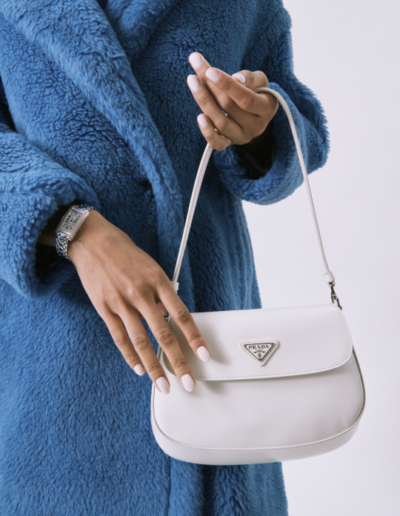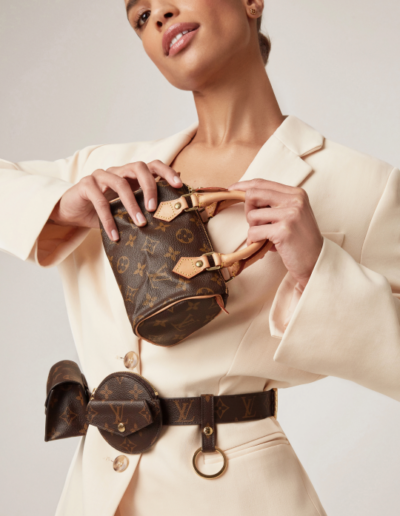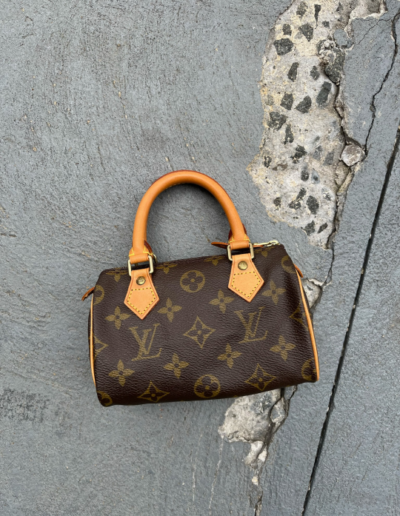DESIGNER 101
Dior 101:
A History
By Taylor M. Sep 8, 2020
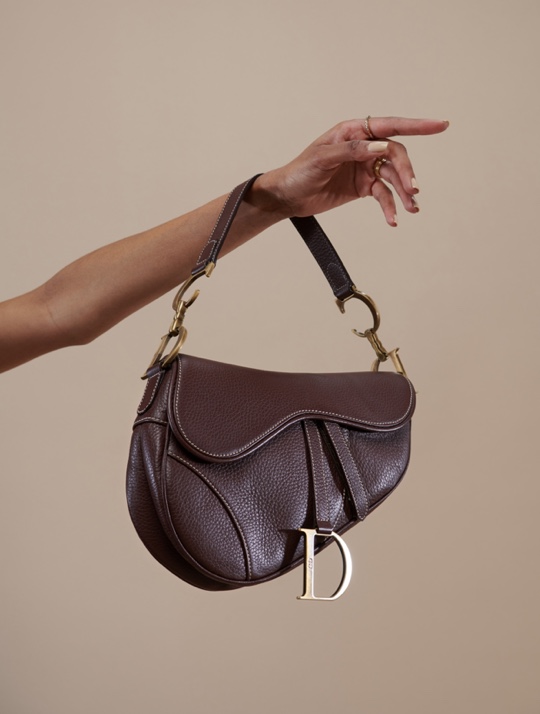
Let’s delve into the history of the French designer and his
namesake fashion house, Christian Dior, which was not only a brand but an exalted symbol of traditional femininity & elegance since 1946. Dior, now a mainstay in the luxury fashion industry, is still a relatively young fashion house, but its history is no less rich than its counterparts.
Before designers like Chanel suited women in shifty chemises and tweed sets, ladies wore tapered waistlines and long, voluptuous skirts. This silhouette was often accompanied by a hat or head covering as well. However, emerging into a post-World War II world, women were opting for more movable garments as their lifestyles shifted and they acquired affinities for showing more leg. Materials had been scarce during wartime as well, so bottom lengths rose and garments lost their bulk. However, not everyone was thrilled that maximalism and extravagance were going out the window at the end of the forties. Christian Dior was among those dismayed by the simplicity of dressing influenced by Chanel and other designers at the time. In 1947, he introduced the “New Look,” which in theory wasn’t new at all. The concept turned back the clock to reclaim the traditionally-flattering female form, cinching the waist and lengthening hemlines to emphasize hourglass figures – but with a modern approach, not yet seen. Ultimately, Dior’s look defined the 1950s for women worldwide.
The Origins of Christian Dior
Christian Dior was born in Granville, France in 1905 and grew up in Paris. Originally trained to work as a French Diplomat, he spent much of his spare time selling his own fashion prints on the street. When he was finished with school, Dior began his professional career in an art gallery selling works of famous painters like Picasso. During the Great Depression, he was forced to close the gallery and began assisting in design at Robert Piguet in 1938. After serving in the French military, he went on to work for Lucien Lelong. At Lelong, Dior designed alongside Pierre Balmain to maintain the fashion industry in the midst of the world war. Like other houses at the time, they kept the business afloat by designing for Nazi officers’ wives and French collaborators. Contrastingly, Dior’s own sister joined the French Resistance, was captured, and survived being held in a concentration camp. His brave sister Catherine was eventually the inspiration behind the “Miss Dior” fragrance.
Once he had gained experience working in couturiers, Dior was ready to launch his namesake brand which disrupted women’s fashion thereafter. The first show was in 1947 and displayed his “New Look,” as it was famously described by the then Harper’s Bazaar editor Carmel Snow. The copious amounts of fabrics (about twenty yards per dress) received some backlash from critics, but overall, his designs achieved the goal of refreshing post-war couture and reinvigorating the French fashion industry.
For the next ten years, Dior saw his brand emerge as a breakthrough in fashion. The fifties were marked by his famous silhouettes (A-line, H-line, and Y-line), and thanks to this, Parisian designers triumphed over American designers once again. Celebrities dawned the iconic looks, including Margot Fonteyn and Rita Hayworth. Dior passed away in 1957, leaving his legacy to Yves Saint Laurent, his assistant and twenty-one-year-old protege.
The Designers at Dior
Yves Saint Laurent was a recent graduate when he was introduced to Dior by Michel De Brunoff, an editor-in-chief at Vogue Paris whom he had met through his father. Saint Laurent’s sketches showed promise, and he quickly established influence at Dior. He began by decorating the stores and designing dresses, and was soon entrusted with greater responsibilities. Laurent wrote of Dior, “He taught me the essential. Then came other influences that, because he had taught me the essential, blended into this essential and found it to be a wonderful and prolific terrain, the necessary seeds that would allow me to assert myself, grow strong, blossom, and finally exude my own universe.”
Saint Laurent ran the Dior house until he was drafted into the French military in the sixties. He was succeeded by Marc Bohan in 1961, who had a similar design record to Dior. Between his experience at Piguet and receiving a strong upbringing in fashion in the shadow of his mother, a hat designer, the makings were all there for him to succeed. Before gaining the title of creative director, Bohan was in charge of Dior’s London collection from 1958 to 1960. He is known for an iconic fall collection in 1966, incorporating inspiration from the film, Doctor Zhivago with fur boots and belts, all while maintaining the feminine romance attributed to the brand’s identity.
Gianfrance Ferre took the position of creative director when Bohan left the label in 1989. He quickly became known for bringing architectural design to womenswear, and was called the Frank Lloyd Wright of fashion. His designs reflected the social structure of the nineties in that they celebrated women and proclaimed female power in the world.
After Ferre came John Galliano, who undoubtedly revved up the drama at Dior. Before he was let go from the company for making public anti-semitic remarks, he was known for over-the-top designs clad with beading and dresses cut on the bias. When Galliano was dismissed, Bill Gaytten took over and Raf Simons was appointed creative director shortly after in 2012.
Maria Grazia Chiuri came to Dior in 2016 from Valentino, where she began as an accessories designer, and continues as creative director of Dior today. As the first woman to head the brand, she has made strong statements on feminism through her collections, notably in 2017 which highlighted the essay, We Should All be Feminists, by Chimamanda Ngozi Adichie. Her expertise and social consciousness was acknowledged when in 2019 she was awarded the highest honor from France, the Légion d’honneur, presented by the French Secretary of Gender Equality. Chiuri also reiterated Dior’s Saddle Bag and implemented it through highly effective influencer marketing, yielding vast success.
Iconic Bag: The Lady Dior
When it came to handbags and accessories, Dior himself was more than particular. A crucial element of any ensemble, the purse was what he believed to be the key transition point that could move the same suit from breakfast to dinner. A change in handbag defined the look’s function and mood; Dior called for simplicity in the mornings and an increase in intricacy into the evenings in his “Little Dictionary of Fashion.” A switch of a handbag was a transformation, as long as it was made with the utmost quality.
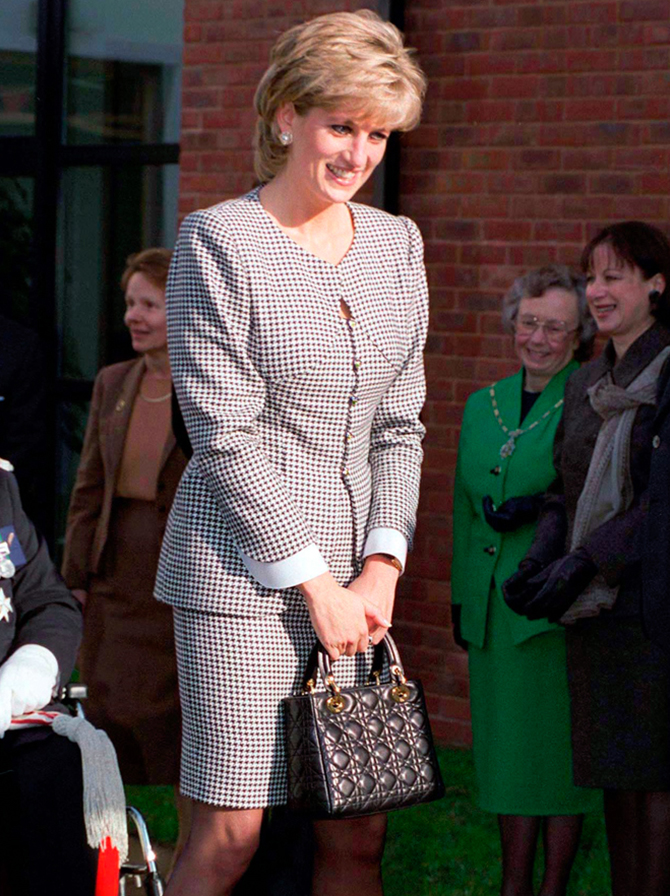
Princess Diana carries the Lady Dior Bag
Source Unknown
With these strong handbag morals instilled in the brand, the ChouChou bag silhouette entered the scene in 1994, under Gianfranco Ferre. This silhouette made a huge impact in the nineties and is highly recognizable today. Elegant in material and sleek in shape, the boxy top handle tote is fit for royalty, which is probably why it was gifted to Lady Di in 1995 and earned her name in response for her adoration, becoming the “Lady Dior.” Much like the bag, Princess Diana was all the rage at the time, representing female empowerment through her powerful dressing and outspokenness. The bag has been revamped over the years in material and colorings, but the shape itself has stood the tests of time and remains one of the most desired bags in the luxury market. One can still find older units of the style, or opt for the exciting new takes that Dior has output more recently. Some noteworthy fabrications include patent, velvet, studded leather, python, tweed, and more!
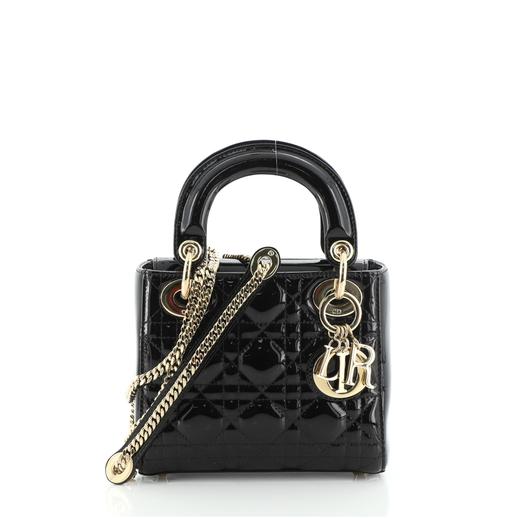
Mini Lady Dior in Patent Leather
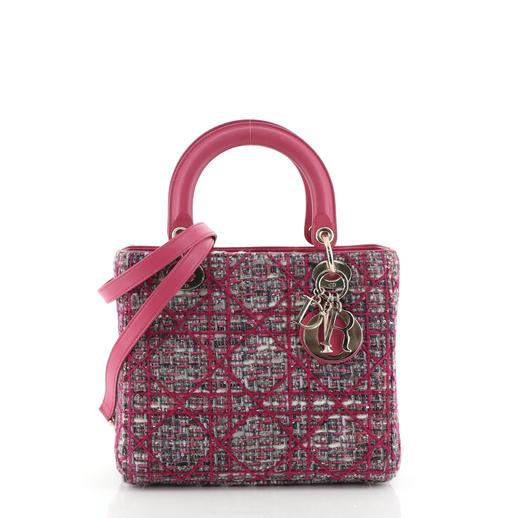
Mini Lady Dior in Tweed
Though Dior has seen a clear majority of male leaders, the brand’s identity has always been situated in celebrating and highlighting the female form with the finest fits and materials. Throughout its rich development, and with the help of its inspired designers, the brand has evolved into a globally adored powerhouse. Each decade has effectively been marked by an iconic Dior aesthetic which highlighted the socio-political environment in which it existed, and it could not be more fitting that a female force is at the top of the brand today.

